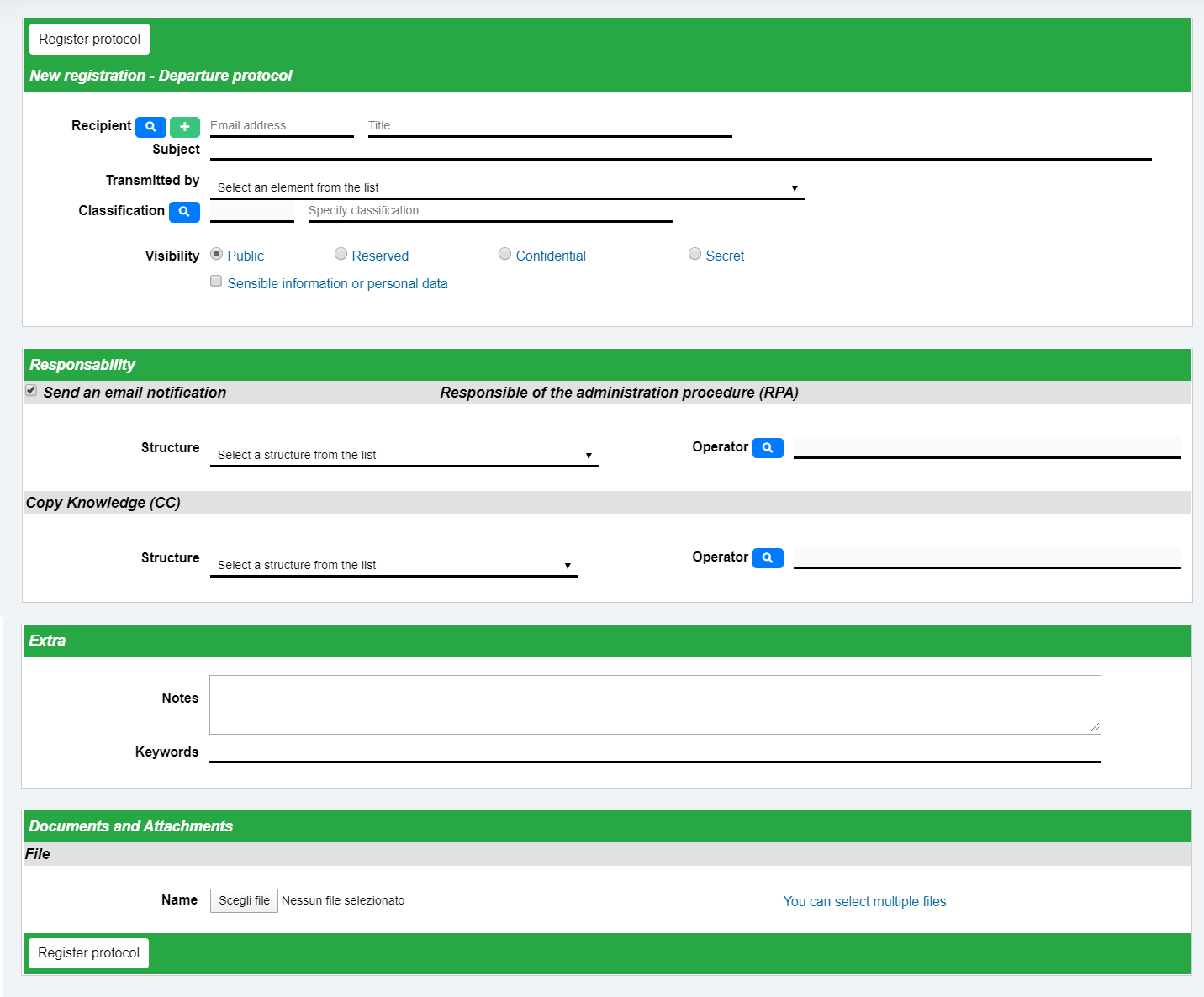
This section contains the functions for the new registration of documents in the IT Protocol. The available buttons depends on the permissions that the operator owns, based on his/her profile.
Documents are registered according to their typology:
1. Registration - Arrival Protocol
Once opened, the page will be divided into four different sections:
- New registration
- Responsibility
- Extra
- Documents and Attachments
1.1 New registration

In the first section, you can assign values to the following fields:
| Sender | Specifies the user that sent the documentation. To select a sender you can search in the registry or create a new external structure/person. |
|---|---|
| Subject | It is the title of the registered documentation |
| Transmitted by | Represents the way the documentation was delivered (i.e. email, hand-delivery, etc..) |
| Classification | Each registration is classified with a unique index; you can select the most appropriate element from the list, or type it on your own |
| Doc. Data | It gives further information about the documentation; i.e. if the received documentation has been registered to the sender protocol, you can specify its protocol registration number. |
| Visibility | According to the permissions of each operator, some documents may not be available to everyone. You can specify the minimum level of permission to read the document; note that the RPA and CC operators will be granted by default |
| Personal data | This field allows you to specify if the documentation contains sensitive or personal data |
It is also possible to create a draft of the registration and save it as such. You will have the possibility to register it in a second moment from your draft menu.If you select draft mode, you will not be able to upload documents at the moment.
1.2 Responsibility

In the responsibility section, you can assign values to the following fields:
| RPA | It's the responsible for the procedure of the documentation workflow |
|---|---|
| CC | You can specify as many Copy Knowledge operators, even belonging to different structures |
| Send an email notification | If selected, an email notification of the registration will be sent to the operators specified as RPA and CC |
1.3 Extra

In the Extra section, you can assign values to the following fields:
| Keywords | |
|---|---|
| Notes | Both these fields can help you to specify any additional information and will help in the research |
1.4 Documents and Attachments

In the final section you will be able to specify the attachments you want to upload and register with the protocol registration. Please note that it will not be possible to update or remove them.
2. Registration - Deferred Arrival Protocol
The deferred protocol allows you to perform a registration if the original date is previous to the current one. It is useful in case there is a technical problem or if the amount of documents to be registered is so much that the registration date is postponed.
The only difference, is that two extra fields are available:

In the Deferred protocol section, you can assign values to the following fields:
| Arrival date | The original date on which the document should have been registered |
|---|---|
| Reason | The reason for the registration delay |
3. Registration - Departure Protocol
The departure protocol is useful when the communications are sent from the organization to an external person/structure, for example when you need to register and send some documents.
The structure of the registration process is the same as for the Arrival Protocol registration.

4. Registration - Internal Protocol (offices)
The internal protocol is useful when the registration of the documentation is only internal to the organization, for example when two documents have to be registered and sent within the same orgazation, but different structures.
Once opened, the page will be divided into four different sections:
- New registration
- Responsibility
- Extra
- Documents and Attachments
4.1 New registration

In the New registration section, you can assign values to the following fields:
| Sender | The field is selected by default and it represents the registration user |
|---|---|
| Transmitted by | Represents the way the documentation was delivered (i.e. email, hand-delivery, etc..) |
| Classification | Each registration is classified with a unique index; you can select the most appropriate element from the list, or type it on your own |
| Visibility | According to the permissions of each operator, some documents may not be available to everyone. You can specify the minimum level of permission to read the document; note that the RPA and CC operators will be granted by default |
| Personal data | This field allows you to specify if the documentation contains sensitive or personal data |
4.2 Responsibility

In the responsibility section, you will find two different sub-sections:
- Sendedr (Draft) which is referred to the structure that sends and creates the documentation
- Recipient (Original) which is referred to the structure that receives the documentation
You can assign values to the following fields:
| RPA - Sender (draft) | It's the responsible for the procedure of the documentation workflow of the structure that sends the documentation |
|---|---|
| RPA - Recipient (Original) | It's the responsible for the procedure of the documentation workflow of the structure that receives the documentation |
| Subject | It's title of the registration |
| CC | You can specify as many Copy Knowledge operators, even belonging to different structures |
| Send an email notification | If selected, an email notification of the registration will be sent to the operators specified as RPA and CC |
1.3 Extra

In the Extra section, you can assign values to the following fields:
| Keywords | |
|---|---|
| Notes | Both these fields can help you to specify any additional information and will help in the research |
1.4 Documents and Attachments

In the final section you will be able to specify the attachments you want to upload and register with the protocol registration. Please note that it will not be possible to update or remove them.

